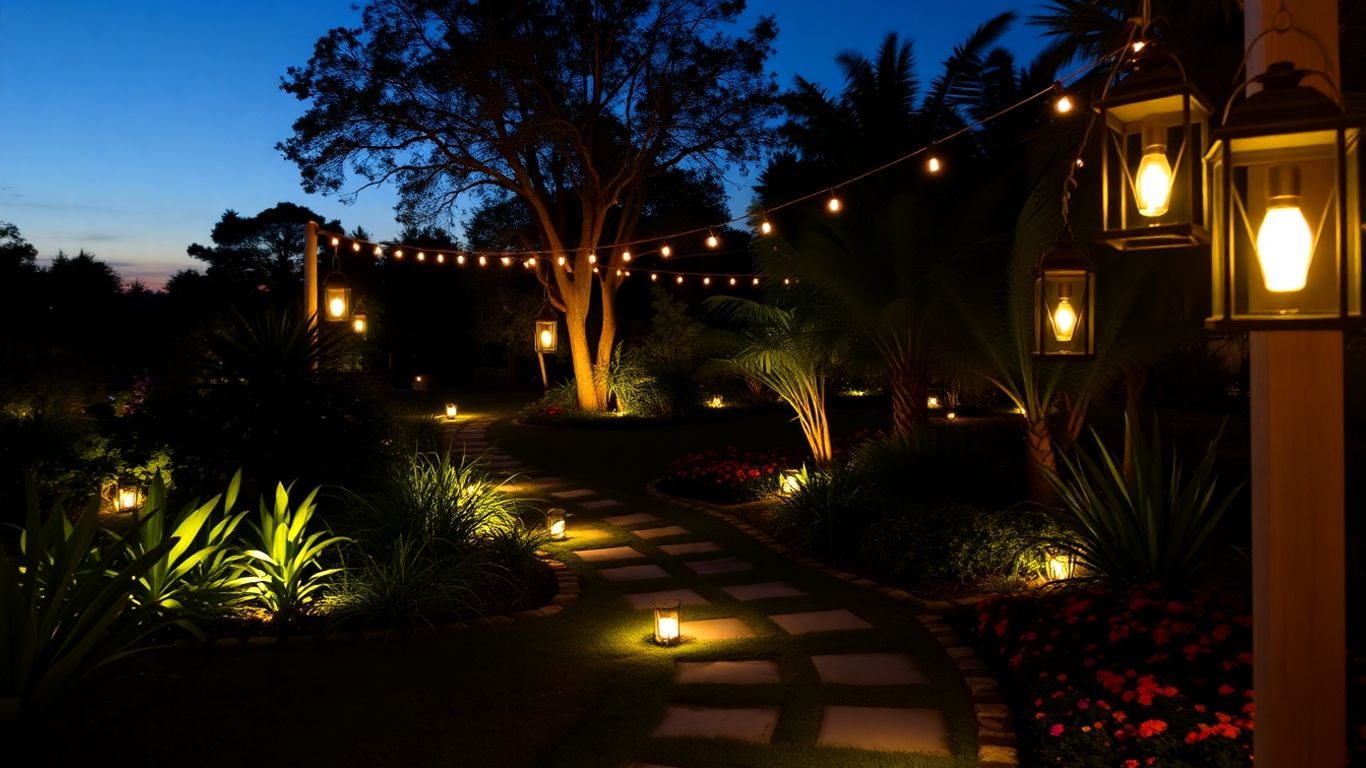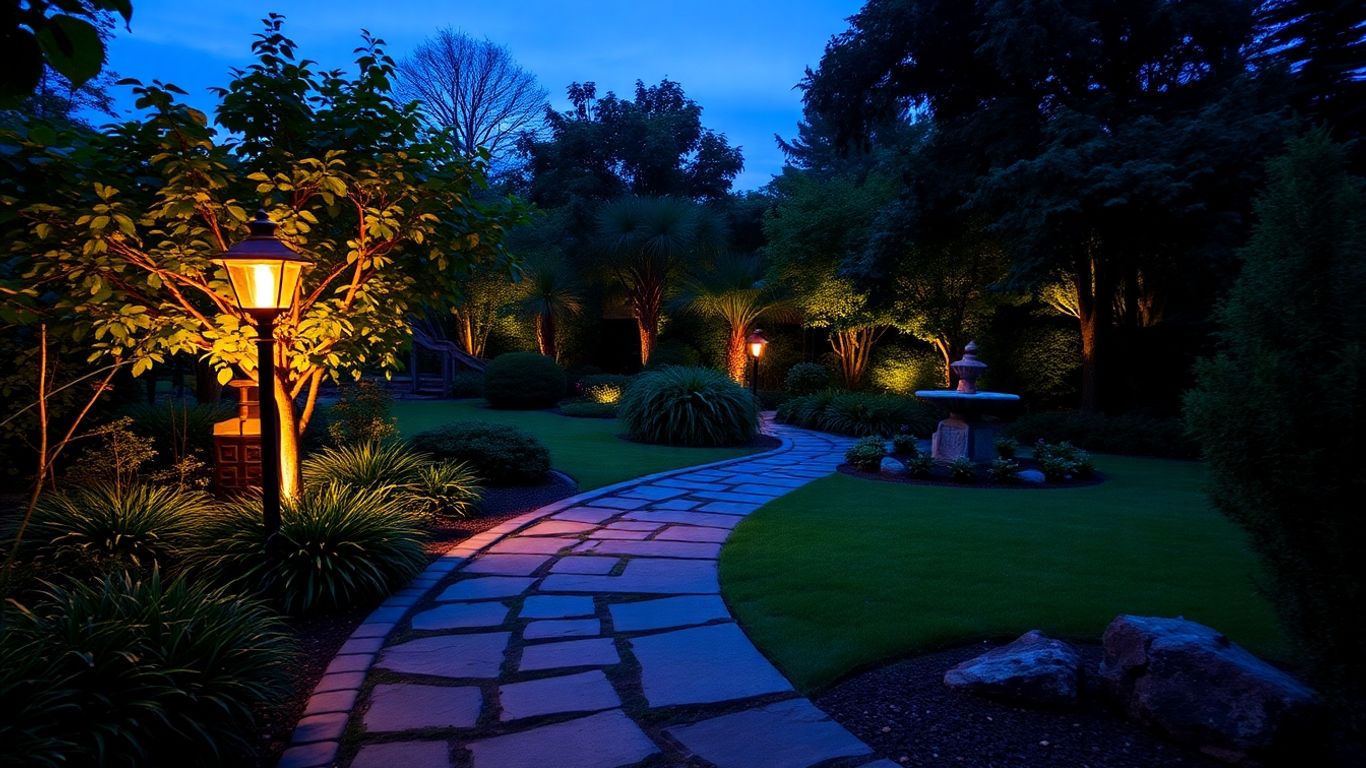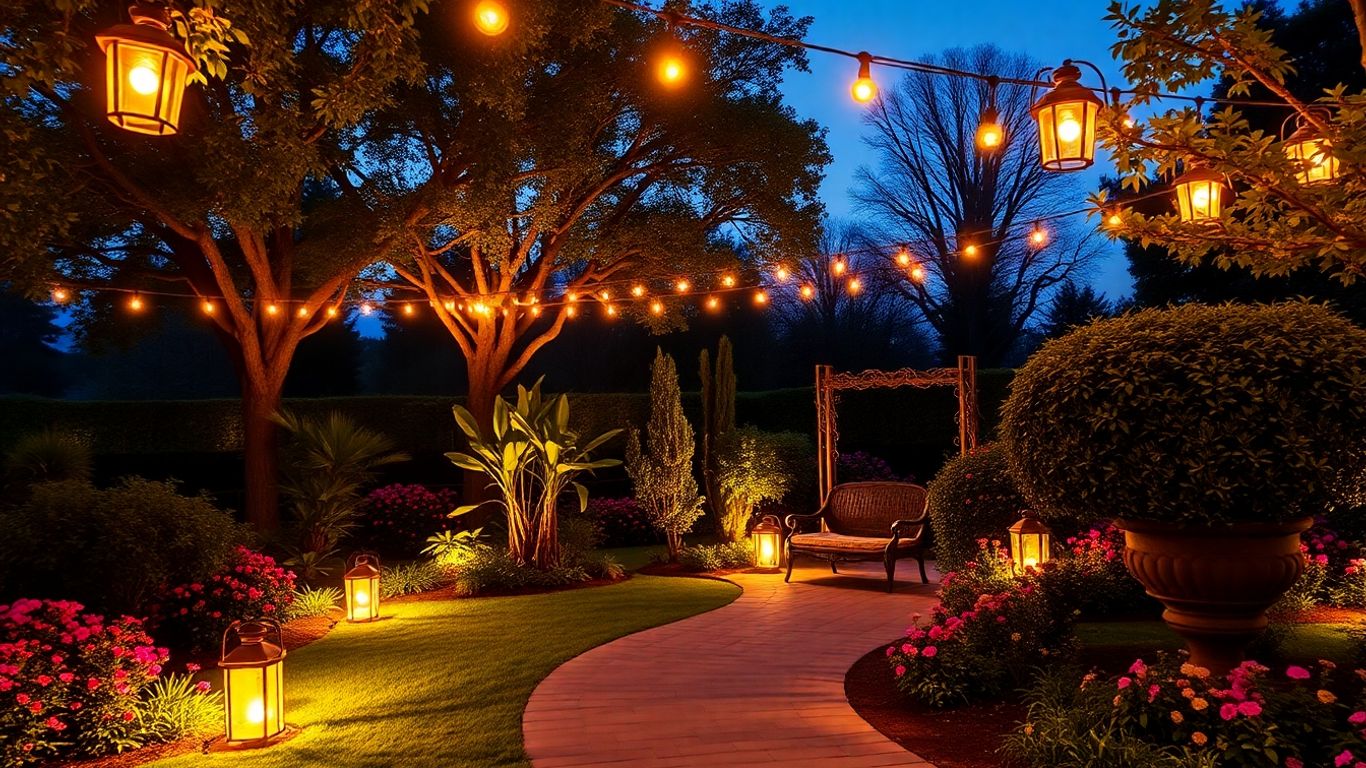Ever walked into your backyard at night and thought, “Wow, it looks so different in the dark”? That’s where garden lighting comes in. It’s not just about seeing where you’re going—it’s about making the space feel inviting, safe, and even a bit magical after sunset. With the right lights, you can highlight your favorite plants, make pathways safer, and turn your garden into a spot you actually want to hang out in after dinner. Whether you’re after something simple or want to go all out, there’s a lot to consider, but it doesn’t have to be complicated. Let’s break down what you need to know about garden lights, from types to design, and even a few mistakes to avoid.
Key Takeaways
- Lighting isn’t just for looks—it helps with safety and makes outdoor spaces more usable at night.
- There are lots of options: path lights, spotlights, string lights, and you can choose between solar or wired setups.
- Layering different types of lights creates a more balanced and comfortable atmosphere in your garden.
- Lighting can highlight features you love, like trees or water, and also make steps and walkways safer.
- Keep up with maintenance and consider energy-efficient choices, like LED or solar, to save money and hassle.
Why Garden Lighting Matters
When you think about your garden after dark, what do you see? Without light, it’s easy for all those thoughtful plants and features to vanish into the shadows. Garden lighting lets you enjoy your outdoor space long after sunset, turning it into a welcoming extension of your home. But there’s way more to it than simply making things brighter.
Here’s why it isn’t just an extra, but something you should really think about:
- It adds a layer of comfort and usability, so you can have a chat outside, keep grilling, or wander the garden any time you want.
- Lighting makes those paths and steps less of a guess in the dark, helping everyone move around without fear of tripping.
- Accentuates the best things in your outdoor area—maybe a gorgeous tree, that new sculpture, or even just your favorite flower patch. With the right light, these details really pop at night.
A little structure never hurts, so let’s see how it impacts everyday use:
| Feature | With Lighting | Without Lighting |
|---|---|---|
| Safety | Easy navigation | Trip hazards |
| Usability | Extended hours | Limited to daylight |
| Aesthetics | Highlights features | Everything blends in |
| Security | Deterrent to intruders | Dark, hidden spots |
On some evenings, lighting felt like the difference between an outdoor living space and a spot that’s just nice only when the sun’s out. Once the lights clicked on, the garden felt bigger, safer, and honestly, a whole lot more inviting.
Best Lights for Backyard Landscaping

It really transforms your outdoor space, both for style and day-to-day use. Before jumping into garden lighting installation, take a look at these popular types to see which will fit your space, budget, and vibe. The best lights for backyard landscaping often strike a balance between practical needs and visual impact.
Pathway Lights
Pathway lights are the backbone of safe, inviting gardens. They’re simple to line along walkways, steps, or even around flower beds. Here’s what they do:
- Guide you safely along paths after sunset
- Highlight landscaping or low garden features
- Help prevent tripping hazards
| Type | Installation | Effect |
|---|---|---|
| Stake lights | Easy, push-in | Subtle, close to the ground |
| Recessed deck | In-floor setup | Seamless, modern |
| Bollard | Fixed or plug | Strong, upright marker |
Spotlights & Uplights
These lights show off trees, shrubs, or garden art. The focus is on angles and direction, not just brightness. Here’s how they help:
- Draw attention to standout plants or sculptures
- Add drama with shadows and highlights
- Make the space usable, not just pretty
Spotlights usually mount low to the ground, while uplights shine upward. Angle these carefully to avoid glare and wasted light.
String & Festoon Lights
If you like a little magic or want to throw a backyard party, string lights or festoon bulbs are your answer. These work especially well for:
Their flexibility means you can easily switch up the look for different events or seasons.
The type of lighting you pick can totally change how the place feels once the sun goes down—sometimes a few well-placed string lights are all it takes to get people outside longer.
Solar vs. Wired Lighting
Let’s talk power. When planning your outdoor lighting installation, you’ll run into two main choices: solar and hardwired.
- Solar Lights: No electrician or cables needed, great for sustainable setups. Limitations? They need sun and usually aren’t as bright—best for accents.
- Wired Lighting: Reliable, brighter, and suited for spots you use a lot (like steps, main patios, driveways). Costs more and needs planning, but it works year-round.
Some folks mix both types for the right balance. When picking the best lights for backyard landscaping, consider how much use each area gets, what the sun exposure is, and how hands-on you want to be with your lighting setup.
Overall, there are lots of choices, but the main types—pathway, spot, string, and solar—let you light up your garden your way. Think about safety, wow-factor, and easy maintenance as you plan out your lighting design.
Design Principles for Garden Lighting
When you start planning your garden lights, it’s easy to get lost in all the product choices and techy options. But here’s the thing: great garden lights begin with a clear plan, not just a bunch of fancy fixtures. Start by actually standing in your garden at dusk, looking for spaces that fade into darkness and those bits you use the most. Map out the places you walk, sit, or want to look at in the evening. This is the first big step. Many folks rush to shop for lights before figuring out what their outdoor living spaces really need.
Layering Light for Ambiance
Layering is the not-so-secret sauce behind beautiful, functional outdoor spaces. The best landscape lighting ideas bring together several types of light, each serving a different role. Try these layers:
- Ambient lighting: This is your general light, like soft wall lights or even shrouded pendants in covered areas. It brings a warm glow that lets you use your space comfortably after sunset.
- Task lighting: Perfect for areas where you cook, read, or need to see what you’re doing—think grilling stations or steps by the patio. Use targeted fixtures to avoid wasting light.
- Accent lighting: Use spots or small uplights to draw attention to standout features, like a favorite tree or a textured wall.
When layering lights, aim for a contrast of light and shadows instead of lighting everything up like a sports stadium. This way, your garden feels cozy, interesting, and full of subtle charm.
Focal Points & Accents
Focusing light on the right features makes your garden pop. With garden lighting design tips like these, you can turn regular details into highlights:
- Choose a few main focal points — maybe a striking tree, an interesting sculpture, or a water feature. Less is more.
- Play with different angles. Sometimes, lighting a tree from the base looks dramatic, while a sideways light up the texture of a wall.
- Consider color temperature; warmer lights often feel natural and inviting after dark.
Here’s a quick at-a-glance guide for lighting focal features:
| Feature | Lighting Approach |
|---|---|
| Statement Tree | Uplight from the base for drama |
| Stone Wall | Grazing (light at an angle) to show off the texture |
| Water Feature | Submersible or hidden underwater spots add visual interest |
Think about keeping a little mystery—don’t try to light everything at once. Good garden design lets some areas fall naturally into shadow, so your eyes are drawn to places you care about most.
Functional Aspects: Safety & Security
When it gets dark, having the right lighting is about more than just showing off your favorite flowers. Good lighting is a huge part of feeling safe and secure in your outdoor space. Tripping on an unseen step or tool is no fun, and calmly walking a path at night without worrying where your foot will land is a relief. At the same time, a property splashed with light can keep unwelcome visitors from sneaking around — most people won’t risk being seen if they have nowhere to hide.
Here’s how it really pulls its weight after sunset:
- Prevents Accidents: Lighting up steps, uneven spots, or garden borders means fewer stumbles and falls, especially for guests unfamiliar with your yard.
- Deters Trespassers: Bright lights take away the cover that potential intruders rely on, making your home a tougher target.
- Reveals Hazards: Things like branches, tools, or even the dog’s favorite chew toy can lurk in the dark — lights let you spot them before they become a problem.
For a quick look, check out how different lighting features stack up for safety and security:
| Lighting Feature | Safety Benefit | Security Benefit |
|---|---|---|
| Pathway Lights | Guides steps, prevents falls | Limits hiding places |
| Spotlights | Highlights hazards | Illuminates dark corners |
| Motion Sensors | Warns of movement | Startles potential intruders |
When you think about extending your outdoor entertaining into the evening, the right lighting keeps everyone comfortable, safe, and lets the good times roll a bit longer. For more outdoor inspiration, consider how well-placed lighting supports both cooking and relaxing spaces in your backyard, making areas useful for any gathering.
Maintenance and Energy Efficiency
When it comes to garden lights, keeping your setup working smoothly goes hand in hand with keeping your energy bills in check. A little regular care and smart choices can make your lights look better, last longer, and cost you less in the long run.
Key Maintenance Steps:
- Clean fixtures every few months to clear away cobwebs, dirt, and water spots that make lights less bright.
- Check bulbs and replace any that are flickering or burned out—don’t leave dark patches.
- Inspect wiring for cracks, animal damage, or loose connections, especially after storms or busy seasons.
- Trim plants and shrubs that start to block your lights; it’s surprising how much growth can ruin the look.
Energy efficiency is a big deal now, and it makes a difference. Most folks end up saving money and hassle by swapping out old incandescent or halogen bulbs for modern LED or solar options. Here’s a simple comparison:
| Light Type | Lifespan (hours) | Energy Use (watts) | Maintenance Level |
|---|---|---|---|
| LED | 25,000+ | 6–12 | Very Low |
| Halogen | 2,000 | 18–42 | Moderate |
| Solar | 10,000+ | – | Very Low |
Some quick energy-saving tips:
- Put lights on timers or motion sensors, so they’re never on longer than needed.
- Use low-output fixtures just for ambiance, and only go bright where safety matters.
- Group lights zones—for example, turn off accent lights but leave the main path lit at bedtime.
Even a quick monthly check makes a huge difference. Skipping maintenance at first feels easy, but a busted light or tangled wire is way more work later. Plus, energy-efficient choices pay off faster than most folks expect.
Outdoor Lighting Tips & Common Mistakes

There’s something satisfying about stepping outside in the evening and seeing your garden softly illuminated—when it’s done right, of course. I’ve seen so many yards fall short due to simple missteps. Let’s zero in on the best outdoor lighting tips and some errors you’ll want to avoid in your setup.
Correct placement and thoughtful planning make all the difference in a successful outdoor lighting scheme. Here’s a quick rundown so you don’t repeat the most common problems:
- Start with a clear plan. Don’t just buy lights and hope for the best—map out where light is actually needed for safety, ambiance, and highlighting features.
- Avoid too much brightness or too many fixtures. Excessive lighting is just as bad as not enough—keep it comfortable for the eyes and neighborhood.
- Stick to durable, weather-resistant fixtures, especially in climates with a lot of rain or harsh seasons. Ottawa, for instance, often requires extra care in material choice. Before jumping in, think about drainage and materials to avoid other common mistakes in outdoor space design.
- Mix types of lighting. Don’t rely on just one solution. Pathway lights, spotlights, and string lights each play different roles, so layering can create a great mood and safer navigation.
- Prioritize energy efficiency. Choose LED bulbs whenever possible, or solar-powered options for accent spots—these cut costs and last longer.
- Check for shadows and glare. Test your lights at night before you permanently install them to avoid dark corners or blinding neighbors.
Mistakes to steer clear of:
- Installing lights too close together or lining pathways in a runway style. It’s harsh and doesn’t look natural.
- Ignoring maintenance—dirty or broken fixtures really ruin the vibe and can be unsafe. Routinely check bulbs, wiring, and placements.
- Forgetting about local wildlife and regulations. Some lights can confuse birds and insects, and you might need permits for extra wiring.
It’s easy to get excited about the look, but don’t let style override function—your guests (and electric bill) will thank you if you balance both safety and atmosphere.
If you want your garden to become a nightly retreat, these outdoor lighting tips will set you on the right track. Remind yourself that it’s about enjoying your space comfortably after sunset, not just seeing it from the house window.
Conclusion
So, that’s pretty much everything you need to know to get started with garden lighting. It’s not just about making things brighter—it’s about making your outdoor space work for you, even after the sun goes down. Whether you want to highlight a favorite tree, keep your steps safe, or just make your backyard feel a bit more inviting, a little planning goes a long way. Try walking through your garden at dusk and see what stands out or feels too dark. Don’t stress about getting it perfect right away; you can always tweak things as you go. The main thing is to have fun with it and pick lights that fit your style and needs. Before you know it, you’ll be spending more time outside, enjoying your garden in a whole new light.
Frequently Asked Questions
What is the main purpose of garden lighting?
It does more than just make your yard look pretty at night. It helps people see where they’re going, keeps everyone safe, and lets you enjoy your outdoor space even after the sun goes down.
Should I choose solar or wired lights for my garden?
Solar lights are easy to set up and save energy because they use sunlight. Wired lights are brighter and more reliable, but they need more work to install. Pick solar for quick fixes or small areas, and wired lights for spaces you use all the time.
How do I highlight special features in my garden with lights?
You can use spotlights or uplights to shine on things like trees, statues, or water fountains. These lights draw attention to your favorite parts of the garden and make them stand out at night.
What’s the best way to make my garden safer with lighting?
Place lights along pathways, steps, and around entrances. This helps people see where they’re walking and keeps everyone from tripping or getting hurt.
How can I save energy with outdoor lighting?
Use LED bulbs because they use less electricity and last longer than regular bulbs. Solar lights are another good choice since they don’t use any power from your house.
How often should I check or clean my garden lights?
Check your lights every few months to make sure they work and are clean. Wipe off dirt, replace bulbs if they burn out, and look for any broken wires or loose parts.

